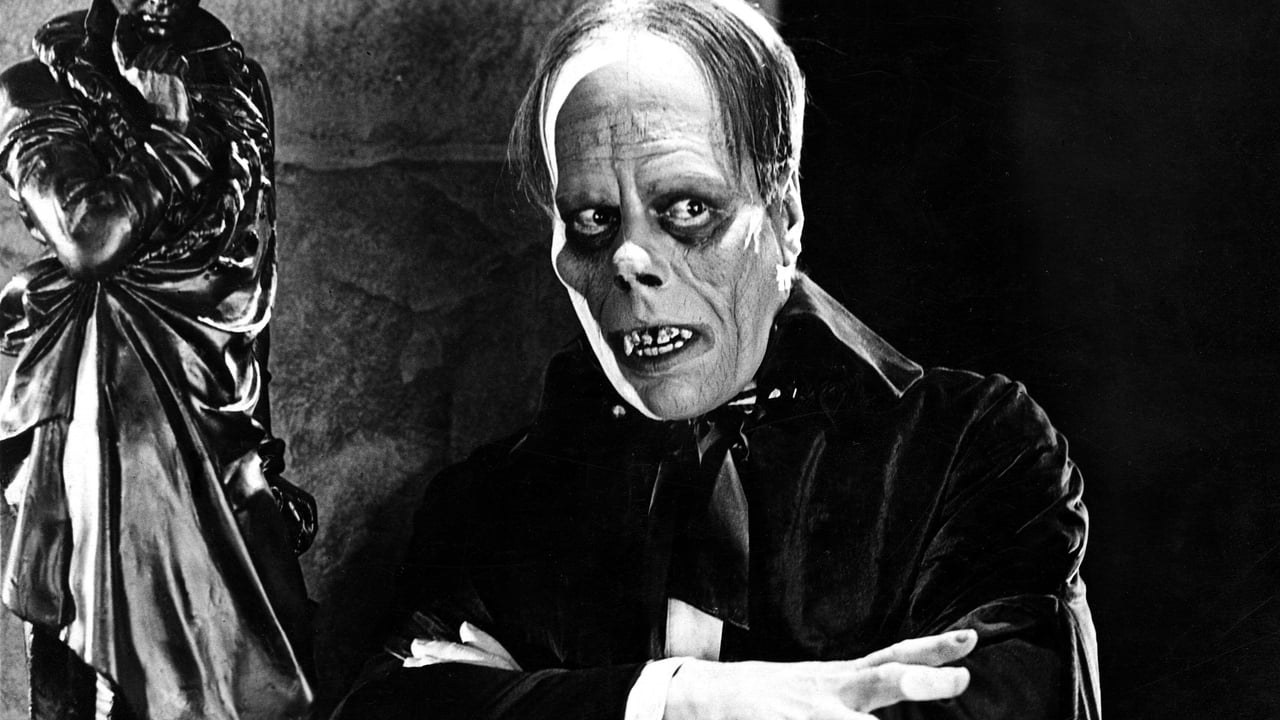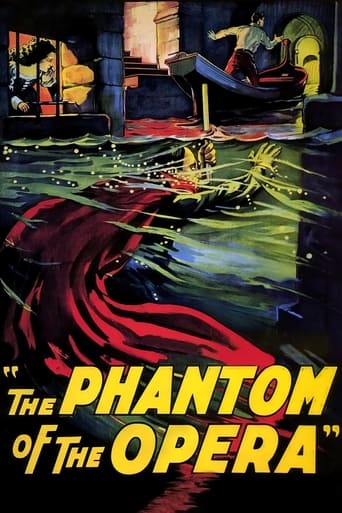

Silent dramas such as "The Birth of a Nation" or "Nosferatu" are all now in public domain, different versions, different soundtracks or color tones but if you want to commit to them, Internet is your friend. However, these movies also ask for a commitment of mind because in the absence of laughs, you can only hang on romance, thrills and atmosphere. Rupert Julian's adaptation of Gaston Leroux' classic "Phantom of the Opera" provides the obligatory trinity and I listed them in order of effectiveness.But while the inclination of romantic silent actors to overact the melodramatic bits can undermine a film's credibility, the acting in "Phantom of the Opera" is pretty decent, although the performance of Lon Chaney turns all the other players into forgettable pawns. But even Chaney gets less interesting in the final act where he's turned into a one-dimensional public enemy instead of the tragic villain we sympathized with. I guess it all comes down to the 'atmosphere' being silent movies' strongest suit, just as it did for "Nosferatu", anticipations are more thrilling than reveals... except for the one reveal.The merit of Lon Chaney, known as the man of a thousand faces (two were enough here) is to act in a way that serves the eerie and ominous ambiance of the Opera. As long as he wears the mask, he's this mysterious "admirer", always sitting at Box five and... well, a whole other 'Persona' in the Greek meaning of the word, which is "mask". And the object of the admiration is Christine (Mary Philbin) a breathtakingly beautiful aspiring singer. The mysterious admirer will see that only Christine would sing the Marguerite part in the representation of "Faust" and a series of written threats and curses prevent Prima Donna Carlotta from singing. We don't literally see the Phantom, but does he need 'acting' when his actions say enough?The first act is remarkable in the way all the main players are kept in the dark. The film starts with the notary deal where the new Opera owners learn about the existence of a Phantom... and a mysterious masked stranger. Naturally, it takes time for everyone to reassemble the pieces of the puzzle but we're ready to embrace the atmosphere and forgive some deficit of subtlety. The reputation of the Phantom precedes him, he's mostly a rumor, but what a rumor, see how he's described by one who saw him: "eyes like holes", "grinning skull", "leprous parchment", "no nose"... Poe wouldn't have been more eloquent and you'll see that it was no misleading advertising. While the Phantom is 'under study', Christine is an understudy and her boyfriend Raoul, an understudy of her heart as she wouldn't let any man interfere with her career. Except in the right way. The admirer, whoever he is and however he manages, allows Christine to get on stage, to sing, since he pledges his eternal love for her and her music, he clearly has an edge over Raoul and his mask doesn't frighten nor impress her. Interestingly, Christine represents our point of view, that masked stranger is fascinating because he embodies two contradictions: power and influence and feelings and devotion, he's both a master and a servant, somewhat good, somewhat evil. It's like the mask has neutralized the persona of the man rather than enhanced it. When Christine says "You're the Phantom!", it doesn't even sound dull, but pointless. Yes, he's the phantom, because that's what man's hatred turned him into and Christine will be safe for as long as she doesn't discover the ugliness. Of course, in an almost Biblical move, Christine's curiosity got the best of her, she hesitates before pulling off the mask while the Phantom, whose name is revealed to be Erik, is solemnly savoring the beauty of the moment, playing the organ with the best company, then she puts off the mask and it's not the face in itself than the horror expression in Chaney's face. Well, it's both.The scene was said to have made people faint and I can believe it, because I dare not imagine how a close-up on Chaney's skull-like face would have felt in the big screen. The camera gets closer as if it was obeying his own injunction: "Feast your eyes! Glut your soul on my accursed ugliness!" I related to this quote, perhaps more than the unmasking, this is a man whose ugliness have made a natural outcast out of him and the only parcel of peace and happiness he could afford had just been destroyed by the very person who inspired. And for what? Curiosity... to see how much of a freak he was, such a small price to prevent him from the only passion he could "earn" and condemn his soul to eternal damnation.Just think of today's virtual relationships, everyone wears a mask, it's named a screen, but sooner or later we'll be confronted to the reality of our look and catalyze the feelings or destroy it. The unmasking is a pivotal moment in the film, as it turns the Monster into an antagonist while asking us to root for Christine. But I couldn't, I hated the way she toyed with his feelings; as soon as she realizes her admirer's hideousness she jumps in the arms of Raoul, and she doesn't do it once but twice, driving Erik into the point of no return. Since the Phantom was victim of his ugliness, I don't think we needed to have any knowledge of some criminal background, if his face drove his vileness, that was enough, wasn't it?I was thrilled by the third act in the cellars of the Opera and with the mob for all the effects and suspense but Erik had to be a tragic villain, not a Nosferatu. And I guess that's how modern audiences will perceive it, as a universal monster... and a Universal monster who paved the way to Dracula, Frankenstein and so many unforgettable horror icons.
... View Moreat the end of silent movie era came a true classic and main triumph belongs to Lon Chaney who plays a mad phantom who'd been madly love on an actress of Paris opera house. Phantom haunts in the opera and masters Christine who he wants to be the main prima donna. mystery things happens and Christine gets her chance on stage. Christine's master and the phantom are same character which Christine finds out too late when phantom already been captured her assuming her to be his and only his property. Christines fiancée finds the way to phantoms cave and finally saves her. mad mob catches phantom and kills him. Lon Chaney makes a remarkable role as a mad and lonely phantom who is possessed by Christine wanting her love. rest of the cast in mainly statistics. sadly hero, Norman Kelly, is charmless and I had problems to take his role seriously. the opera gives a fine Gothic atmosphere to the film.
... View MoreSo cries the Phantom in the legendary unmasking scene in Rupert Julian's 1925 The Phantom of the Opera. This romantic-horror film about a depressed and horrifically disfigured criminal searching for love and human acceptance from an opera singer has been placed among the greatest stories on human nature. Yes, Andrew Lloyd Webber's 2004 Broadway musical-film is much more popular and seen. In fact, I have seen the musical both in stage and screen form many more times than the Phantom's kill count altogether. Even though Webber's version had the advantages of an enormous budget (over 102 times the cost of the original), he couldn't pull of the trick that Julian had done years before with this one.Unlike Webber's version, we don't see a dashing Gerald Butler with a face only made ugly by word of mouth, but instead we start with fright at Lon Chaney's skeletal Phantom, a horrible, disfigured monster. Yes, his physical hideousness plays a huge role in the plot. This despised monster has lived in the labyrinth of cellars beneath the Paris Opera House for years, tormenting and casting an eerie shadow over the Opera. But his eye is on a young Christine Daae (Mary Philbin), the understudy of the lead singer Carlotta hoping for her big break. Then, after years of planning, he casts the bait. Using his fearful reputation and homicidal talent as a tool, he gives Christine chance after chance of success and turns the ignorant Christine to love and adore him more than her fiancé, Vicomte Raoul De Chagny (the extraordinary Norman Kerry). Reeling in the unsuspecting catch, the Phantom doesn't seem to know of Raoul still desperately hoping and searching.Inherently, the films and silent films of the 20's to 40's were clean, although like Disney's animated movies, they contain some slight and easy- to-miss, suggestive dialogue. But in this Phantom, that dialogue is even fewer and subtler than known of the time. But weighing out that positive is the film's level of horror (still a PG level at the most, for frightening images). Truth be told, the most frightening scene has to be the dreadful unmasking of Lon Chaney's monster; it unexpectedly shocks the audience as much as Christine is alarmed.This Phantom is a murderer, propagandist, manipulator and a seducer. Though not seen for decades, he was the actual landlord of Opera House, collecting rent from the managers and haunting Box 5 of the theatre. As the story goes, the Phantom was an escapee from an insane prison only wishing to be loved and accepted like every other man, Erik by name. The original ending had the Phantom found at his organ, dead from a broken heart. This ending crafted the Phantom to be a more romantic and more human character, but was discarded for a climactic chase kept in the release. The version that I included here is the shorter 1996 re-release with Carl Davis' re-score. Still, the Phantom's morbid romantic fantasies stick to us along as much as Chaney's astonishing make-up tricks. So, choose a version on YouTube, switch the sound off, turn on your favorite "scary" music and watch along with your significant other.
... View MoreFavorite Quote - "His eyes are ghastly beads in which there is no light - Like holes in a grinning skull!" Released in 1925 - With Lon Chaney's compelling performance, as "The Phantom", being one of this picture's strongest assets, here is a production (filmed on a grand scale) that I'd say was one of the most civilized and cultured horror movies of all time.Set in and around the magnificent Paris Opera House (in Paris, France, of course), this tragic story of obsession, revenge and unrequited love is both a finely-tuned and nicely-paced tale that holds the viewer's rapt attention right from its eerie and intriguing opening, to its climatic finish with the angry mob in hot pursuit of "The Phantom", who is fleeing for his life.This is a film that is certainly not short on riveting drama.Besides the scene where "The Phantom" brings down the massive chandelier onto the heads of the opera-house's audience - The scene where Christine Daae tears away "The Phantom's" mask to reveal the hideous ugliness below, has got to be one of the most shocking moments in horror-movie history.Now 90 years old, I highly recommend this film to anyone who enjoys a genuine scare in the good, old-fashioned way, sans guts-n-gore.
... View More